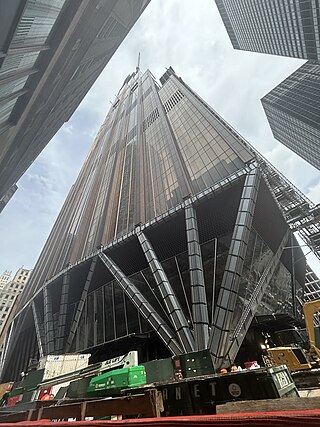
JPMorgan Chase & Co. is an American multinational finance company headquartered in New York City and incorporated in Delaware. It is the largest bank in the United States and the world's largest bank by market capitalization as of 2023. As the largest of Big Four banks, the firm is considered systemically important by the Financial Stability Board. Its size and scale have often led to enhanced regulatory oversight as well as the maintenance of an internal "Fortress Balance Sheet". The firm is temporarily headquartered at 383 Madison Avenue in Midtown Manhattan and is set to move back across the street into the under-construction JPMorgan Chase Building at 270 Park Avenue in 2025.

Niagara Square is a public square located at the intersections of Delaware Avenue, Court Street, Genesee Street, and Niagara Street in Buffalo, New York. It is the central hub of Joseph Ellicott's original radial street pattern that he designed in 1804 for the then village of New Amsterdam. It continues to be the nexus of downtown Buffalo.
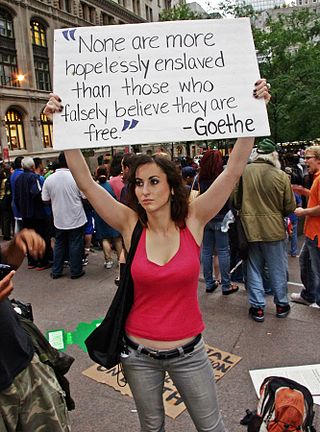
The following is a timeline of Occupy Wall Street (OWS), a protest which began on September 17, 2011 on Wall Street, the financial district of New York City and included the occupation of Zuccotti Park, where protesters established a permanent encampment. The Occupy movement splintered after NYC Mayor Bloomberg had police raid the encampment in Zuccotti Park on November 15, 2011. The timeline here is limited to this particular protest during this approximate time-frame.

Occupy Seattle was a series of demonstrations in Seattle, Washington, United States in 2011 and 2012, that formed part of the wider Occupy movement taking place in numerous U.S. and world cities at that time. The demonstrations were particularly focused on the city's downtown area including Westlake Park and Seattle City Hall; their stated aim was to oppose wealth inequality, perceived corporate greed, and corruption in the banking and economic systems of the United States.
Occupy Ashland included a peaceful protest and demonstration against economic inequality, corporate greed and the influence of corporations and lobbyists on government which has taken place in Ashland, Oregon, United States since 6 October 2011. The protests began in solidarity with the Occupy Wall Street protests in New York. The protests included an occupation of the downtown Plaza and a daily picket outside the JPMorgan Chase branch in Ashland.
Occupy Atlanta has included protests and demonstrations. Occupy Atlanta began on October 6, 2011 in Woodruff Park, located in downtown Atlanta, Georgia. As part of the Occupy movement, it is inspired by Occupy Wall Street which began in New York City on September 17.

The Occupy movement was an international populist socio-political movement that expressed opposition to social and economic inequality and to the perceived lack of real democracy around the world. It aimed primarily to advance social and economic justice and different forms of democracy. The movement has had many different scopes, since local groups often had different focuses, but its prime concerns included how large corporations and the global financial system control the world in a way that disproportionately benefits a minority, undermines democracy and causes instability.
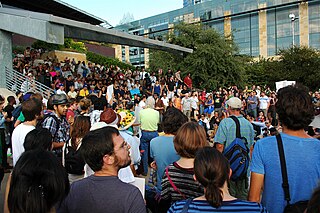
Occupy Austin was a collaboration that began on October 6, 2011 at City Hall in Austin, Texas as an occupation and peaceful protest. It is affiliated with the Occupy Wall Street movement that began in New York City, and also with the "Occupy" protests in the United States and around the world. At the center of the occupation is the General Assembly, where the community comes out and tries to come to consensus on proposals for action.
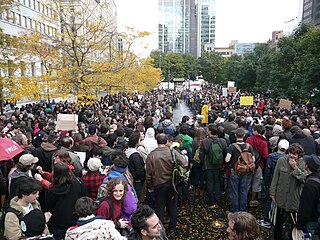
Occupy Canada was a collective of peaceful protests and demonstrations that were part of the larger Occupy Together movement which first manifested in the financial district of New York City with Occupy Wall Street, and subsequently spread to over 900 cities around the world.

Occupy London was a political movement in London, England, and part of the international Occupy movement. While some media described it as an "anti-capitalist" movement, in the statement written and endorsed by consensus by the Occupy assembly in the first two days of the occupation, occupiers defined themselves as a movement working to create alternatives to an "unjust and undemocratic" system. A second statement endorsed the following day called for "real global democracy". Due to a pre-emptive injunction, the protesters were prevented from their original aim to camp outside the London Stock Exchange. A camp was set up nearby next to St Paul's Cathedral. On 18 January 2012, Mr Justice Lindblom granted an injunction against continuation of the protest but the protesters remained in place pending an appeal. The appeal was refused on 22 February, and just past midnight on 28 February, bailiffs supported by City of London Police began to remove the tents.

The 15 October 2011 global protests were part of a series of protests inspired by the Arab Spring, the Icelandic protests, the Portuguese "Geração à Rasca", the Spanish "Indignants", the Greek protests, and the Occupy movement. The protests were launched under the slogan "United for #GlobalChange", to which the slogan "United for Global Democracy" was added by many people's assemblies. The protest was first called for by the Spanish Plataforma ¡Democracia Real YA! in May 2011 and endorsed by people's assemblies across the world. Reasons were varied but mainly targeted growing economic inequality, corporate influence over government and international institutions, and the lack of truly democratic institutions allowing direct public participation at all levels, local to global. Global demonstrations were held on 15 October in more than 950 cities in 82 countries. The date was chosen to coincide with the 5-month anniversary of the first protest in Spain. General assemblies, the social network n-1, mailing lists, Mumble voice chat, open pads such as Pirate Pad and Titan Pad, and Facebook were used to coordinate the events. Some protests were only a few hundred in number, whereas others numbered in the hundreds of thousands, with the largest in Madrid numbering half a million and the second largest city Barcelona with 400,000.
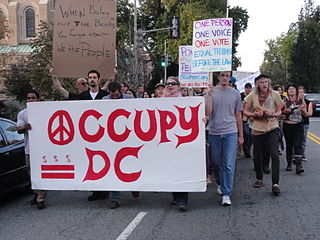
Occupy D.C. was an occupation of public space in Washington, D.C. based at McPherson Square and connected to the Occupy movements that sprung up across the United States in Fall 2011. The group had been demonstrating in McPherson Square since October 1, 2011, and in Freedom Plaza since October 6. Despite crackdowns on other Occupy projects across the country, federal authorities claimed on November 15 that they have no plans to clear McPherson Square Park. The National Park Service decided against eviction after meeting with activists and discussing health and safety conditions.

Occupy Houston is a Houston, Texas-based activist group best known for alleged plots against it by the Federal Bureau of Investigation, investigated and called out on in court by Occupy protester Ryan Shapiro, and for being set up by the Austin Police Department. Occupy Houston was a collaboration that has included occupation protests that stand in solidarity with Occupy Wall Street. The planned occupation officially started in Houston, Texas on Thursday October 6, 2011 when protesters returned from JP Morgan Chase Tower to establish an encampment at Hermann Square Plaza. During the JPMorgan Chase demonstration there were not any confrontations with the police and numerous different passerby were reported to have sympathized with the tone of the protesters. That same night the police were reported to have commented on how well behaved the protesters were.

Occupy Melbourne was a social movement which took place from late 2011 to mid 2012 in Melbourne, Australia as part of the global Occupy movement Participants expressed grievances concerning economic inequality, social injustice, corruption in the financial sector, corporate greed and the influence of companies and lobbyists on government. Protests began on 15 October 2011 in City Square with a 6-day-long protest encampment, from which people were forcibly evicted by Victoria Police at the request of the City of Melbourne CEO on 21 October 2011. From 2 November 2011, Occupy set up camp in Treasury Gardens before being moved on from that location in December. A significantly diminished number of protesters set up camp at Father Bob's church at his invitation until his retirement in January 2012. Physical manifestations of the movement had largely dissipated by mid-2012 though it adopted a strategy of decentralisation and became influential in the creation of new community networks, affinity groups and collectives.

The Occupy movement spread to many other cities in the United States and worldwide beginning with the Occupy Wall Street protests in New York City in September 2011. The movement sought to advance social and economic justice and different forms of democracy but each local group varied in specific aims. The demonstrations and encampment in New York City spread to other major and smaller cities. Some camps lasted through 2012. What follows is an alphabetical, non-chronological summary of Occupy encampments in the United States.

Occupy Baltimore was a collaboration that included peaceful protests and demonstrations. Occupy Baltimore began on October 4, 2011, in Baltimore, Maryland, in McKeldin Square near the Inner Harbor area of Downtown Baltimore. It is one of the many Occupy movements around the United States and worldwide, inspired by Occupy Wall Street.
Steven J. Baum, P.C., was a law firm headquartered in Amherst, New York, United States. It was founded as Marvin R. Baum, P.C. in 1972, and remained under that name until Marvin Baum's death in 1999, after which his son Steven inherited the business and renamed it after himself. Its practice was primarily in real estate law, particularly in representing lenders and servicers in residential foreclosure actions in its later years.

Occupy Homes or Occupy Our Homes is part of the Occupy movement which attempts to prevent the foreclosure of people's homes. Protesters delay foreclosures by camping out on the foreclosed property. They also stage protests at the banks responsible for the ongoing foreclosure crisis, sometimes blocking their entrances. It has been compared to the direct action taken by people to prevent home foreclosures during the Great Depression in the United States.

Occupy Redwood City was a collaboration that began with peaceful protests, demonstrations, and general assemblies in front of the historic San Mateo County Courthouse in Redwood City, California. The demonstration was inspired by Occupy Wall Street and is part of the larger "Occupy" protest movement.

Occupy Minneapolis (OccupyMN) is a grassroots collaboration that began in October 2011 with a series of demonstrations in Minneapolis, Minnesota. Protesters have staged numerous occupations, most notably of the Hennepin County Government Center plaza.


















